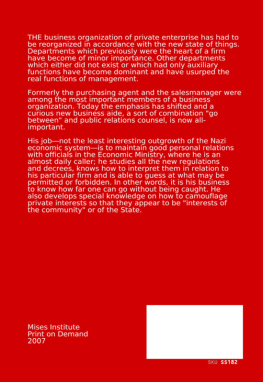
This edition is published by Papamoa Press www.pp-publishing.com
To join our mailing list for new titles or for issues with our books papamoapress@gmail.com
Or on Facebook
Text originally published in 1951 under the same title.
Papamoa Press 2017, all rights reserved. No part of this publication may be reproduced, stored in a retrieval system or transmitted by any means, electrical, mechanical or otherwise without the written permission of the copyright holder.
Publishers Note
Although in most cases we have retained the Authors original spelling and grammar to authentically reproduce the work of the Author and the original intent of such material, some additional notes and clarifications have been added for the modern readers benefit.
We have also made every effort to include all maps and illustrations of the original edition the limitations of formatting do not allow of including larger maps, we will upload as many of these maps as possible.
BETWEEN THE IRON AND THE PINE:
A BIOGRAPHY OF A PIONEER FAMILY AND A PIONEER TOWN
by
LEWIS C. REIMANN
TABLE OF CONTENTS
Contents
TABLE OF CONTENTS
DEDICATION
This factual account of my boyhood days in Iron River, Michigan, is dedicated to my loving Mother who bore me, nursed me, cared for me, guided me through my youth and believed in me. To her I owe all that I am and all that I aspire to be. It was she who bore the burden of a large family, suffered when we were hurt, comforted us in our disappointments, deprived herself so we might have more, and saw her hopes and dreams come true when her children fulfilled her fondest hopes. My sainted Mother, my guide and inspiration.
FOREWORD
When a Chicago financier was invited in the early Eighties to invest his money in the infant iron mining and lumber industries of Iron County of the Upper Peninsula of Michigan, he sniffed:
Iron County? Hell, its too far away from anywhere to ever amount to anything
Little did this man of money expect that the giant white pine of that virgin land would go into the building of most of the homes of his native Chicago and other thriving young cities of the middle west. Nor that the iron ore dug from its fabulously rich mines result in the defeat of the Kaiser and Hitler. He had no way of knowing Iron River was to be the home of Carrie Jacobs Bond whose songs were to be sung the world over. Nor that I, one of the Reimann Bakers Dozen, would write this saga of the North seventy years after he made his brash statement.
How did all this come about? How did this backwoods community, hidden in the dark pine-covered hills in that far-away land, become a great factor in the building of this nation?
Well, here is the tale, written in a distant city by the author as he sits before his fireplace recalling his boyhood days at the turn of the Century.
If the language is rough in spots and the scenes are rugged at times, it is my design to present the life of the day as it really was. If some of the characters and events resemble some of the real events and characters of the past, living or dead, it is purely intentional.
The Author
ACKNOWLEDGEMENTS
While this book was written out of my own recollections of the early days in the Iron River District, many others have contributed to its success by refreshing my memory on some of the history and anecdotes and by assisting me in finding some of the Oldtimers who were free in telling me about those early days of struggle Between The Iron and The Pine.
Among those who contributed this valuable material were Jim Murphy of Elmwood, Mrs. A. W. Quirt, her daughter Mrs. Lila Quirt Purcell, Mrs. Hjalmer Magnet, Bob Solberg, my brother William Reimann and his daughter, Ruth, Leslie Fisher, Mrs. Herbert Fisher, John J. Corbett, Joe Brown, John Ennis, John Westerberg, Mannie Krans, George Breen, Dominic Dascola, Io Oshins, Gus Ruus, Mary Lorenz, Otis Meehan, Mrs. Kathryn Richardson Chandler, Charles E. Good and many others.
Others were Walter F. Gries of Ishpeming, who contributed some Cousin Jack tales, N. J. Nolden of Escanaba for Indian stories, Martin LaVoilette of Stambaugh, mining stories, Mary Mertins for her story on the Stealing the Court House, Alton P. W. Hewett for Choose Your Partners, William Duchane, editor of the Escanaba Daily Press for the Dan Seavey story, Charlie Larson of Escanaba for some Finnish stories, and for editorial advice were George Reeves, the author of The Man From South Dakota, Clarence H. Dykeman, author, and Professor Carlton F. Wells of the University of Michigan.
These good people have my gratitude for helping to make this saga a success.
CHAPTER IBETWEEN THE IRON AND THE PINE
A Boys Eye View
The little log house, in which most of the Reimann tribe saw their first light of day unattended by a doctor, stood on the peak of mile-high Stambaugh Hill overlooking the Iron River valley and the stream below. It was a crude two-story cabin with a sleeping attic and an attached log barn, just a speck in the surrounding wilderness of pine, hemlock and maple. The young village of Iron River lay below in a triangular piece of ground, hemmed in tightly on two sides by dark towering, timbered hills and by a little stream, called the Iron, on the third.
On all sides as far as our eyes could reach was the vast forest extending over the rugged hills. The giant white pines topped the hardwood undergrowth like a velvet cloth laid over the landscape, waving and undulating when the north winds blew across them, a soft vista of green and black. Roads radiated out in several directions from the scattered town,-highways over which rugged men and great teams struggled to bring down the millions of logs to the rollways on the river bank and to the steaming sawmill at the edge of wilderness.
To the northwest and the southwest rose the dark upper structures of mining shafts and great stockpiles of red iron ore dug from the bowels below the ground which once was covered by a virgin forest.
Between the Iron and the Pine men struggled to wrest a living. Lumberjacks came from the woods of Maine and the forests of northern Europe and miners from the mines of Englands Cornwall and south-Europe; and others, like my father, came without previous skill at either industry, to make places for themselves wherever they could in the crisp and rugged environment which lived essentially on lumber and iron ore.
To the men who worked the mines and the woods for pay, life in the Northern Peninsula was harsh and demanding, and the goal was one of wealth distant; but to a boy who saw only people, people with familiar names and familiar faces, life was vivid and colorful. The Main Street of Iron River appropriately enough was paved with red iron ore rock and its raised walks were of plank from the green pine forests, but the color I saw then and remember now was the color of the people.
If on an early morning I were to follow the red iron rock topped road down Stambaugh Hill as the fog lifted off the Iron River stream, cross the little plank bridge to the village and walk up the hill to Main Street, I would come first to Frank Camins ice house and root-cellar beer vault, where Franks big steel-grey Percher on stood patiently hitched to the beer wagon preparatory to supplying the local saloons with the cooling brew that made Milwaukee famous, kegs piled high and topped with chunks of lake Ice mixed with marsh hay to keep the contents cool.














